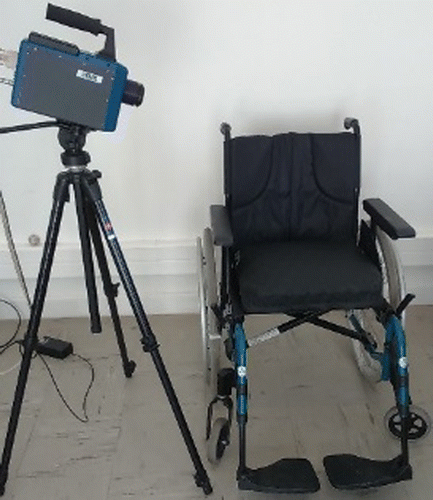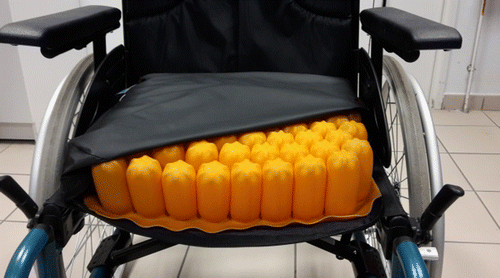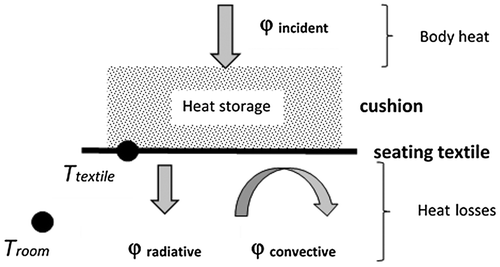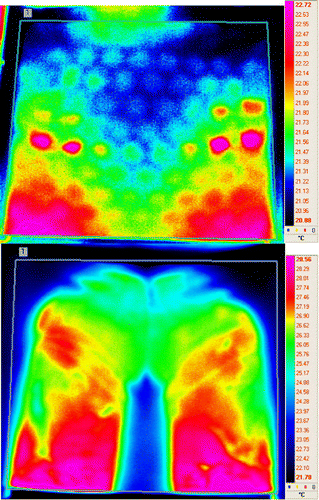 ?Mathematical formulae have been encoded as MathML and are displayed in this HTML version using MathJax in order to improve their display. Uncheck the box to turn MathJax off. This feature requires Javascript. Click on a formula to zoom.
?Mathematical formulae have been encoded as MathML and are displayed in this HTML version using MathJax in order to improve their display. Uncheck the box to turn MathJax off. This feature requires Javascript. Click on a formula to zoom.1. Introduction
The pressure ulcers are injuries caused by a constant pressure and without slackening, which damage skin and the subcutaneous flesh, because of the lack of mobility and blood circulation. The injuries sometimes also result from the friction of the skin against another surface or from the slip of 2 skin layers one against the other, in opposed directions, and which they damage the flesh which are in lower part. With that is added the effects of humidity and temperature (Fisher et al. Citation1978; Stewart et al. Citation1980) which softened the patient and which reduce his resistance. The effects of pressure on ulcers are well-known and were the object of several studies in literature (Mohanty and Mahapatra Citation2014). In the present study we will be interested in the effects of the temperature and his impact on the skin softening which can increase the ulcers environment. We propose a methodology to characterize the thermal performances of cushion environment using the infrared thermography, inspired from (Ferrarin and Ludwig Citation2000). The aim of this paper was to develop and modelize the effect of temperature on the cushion environment of users. Such a modeling has never been developed in literature and represents the originality of our study. After the quantification of temperature studying distribution on cushion seat and using the infrared methodology, the temperature impact was estimated through a simple convector-radiative model.
2. Experimental set-up and protocol
2.1 Set-up
A CEDIP Titanium infrared camera (640x512 InSb detectors – sensitivity about 20 mK between 1.5 and 5 μm wavelength) was used to record thermal maps of both sides of the wheelchair cushion. In order to avoid emissivity variations and to ensure the environmental reflexions are constant, all the infrared images were taken perpendicularly to the cushion.
Figure hereafter presents the material used for the study, and Figure shows the structure of the studied honeycomb-structured cushion.
2.2 Protocol
The study was carried out with a 34 years old healthy participant, of 173 cm height and 75 kg weight. The subject was informed of the nature, purpose and duration of the study and be familiar with the experimental protocol.
A first series of thermal maps was recorded before the participant sits on the wheelchair in order to check the initial thermal uniformity of the seat; it showed, as expected, that the temperature was uniform.
Then the same measurements were carried out after a 35 min sitting of the participant on cushion. The first infrared image was taken on the upper side of the cushion, the second one on the lower side, and the last one on the canvas of the wheelchair.
3. Thermal modeling
A simple convecto-radiative modelling for the heat loss rate per square meter through the wheelchair cushion has been considered (Figure ).
The heat loss rate per square meter can then be expressed as:
Where s is the Stefan constant and hc the convective coefficient. According to a complementary study, the emissivity of the downward seating textile was found to be ϵ = 0.95; the convective heat transfer coefficient was determined by a correlation established by Schulenberg (1985).
4. Results and discussion
The first qualitative results are presented on Figure : one can note the influence of the cushion on the uniformity of the thermal map
On the quantitative point of view, it has been calculated that the presence of the cushion leads to a decrease in the heat loss process, in the order of 73%.
Though comparisons between the heat losses found from the reference case of the present thermal experiments and the Ashrae (1989) estimation are difficult to establish (due to the influence of the clothes on the thermal resistance), the order of magnitude of our results is the same as those found by Ashrae for seated persons, namely about 46 W/m².
Table 1. Thermal heat loss rates though the seat.
4. Conclusions
Results showed that the influence of the cushion on the uniformity of the heat losses, but also on the heat dissipation. The results obtained will permit to predict the scale of temperature necessary for the comfortable position and feeling of patient. Through our study, the results and in collaboration with manufacturers will permit to improve cushion and the daily life of patient. The predictions based on thermal analysis of the interaction between user and cushion will allow the better advises on the new conception of the product satisfying the comfort of users.
References
- Ferrarin M, Ludwig N. 2000. Analysis of thermal properties of wheelchair cushions with thermography. Med Biol Eng Comput. 38(1):31–34.10.1007/BF02344685
- Fisher SV, Szymke TE, Apte SY, Kosiak M. 1978. Wheelchair cushion effect on skin temperature. Arch Phys Med Rehab. 59(2):68–72.
- Mohanty PP, Mahapatra SS. 2014. A finite element approach for analyzing the effect of cushion type and thickness on pressure ulcer. Int J Ind Ergon. 44(4):499–509.10.1016/j.ergon.2014.03.003
- Stewart SEC, Palmieri V, Cochran GVB. 1980. Wheelchair cushion effect on skin temperature, heat flux, and relative humidity. Arch Phys Med Rehab. 61(5):229–233.




